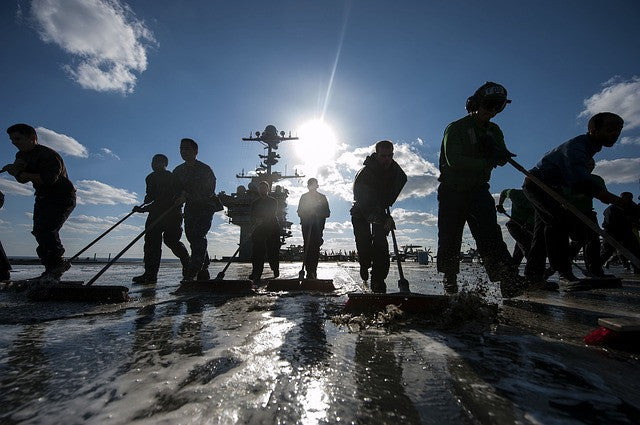Sizing Guide
GUIDE TO MEASURING YOUR WRIST FOR ADJUSTABLE BRACELETS

GUIDE TO MEASURING YOUR WRIST FOR BUCKLED BRACELETS

April 15, 2017

Through the old War Department long time ago, DARPA or any number of privately-owned businesses it dispatched, the U.S. military was the chief inventive force in American technological resourcefulness. Its items not just survived the move from wartime to peace, it also flourished in the market. Here's a snappy rundown of the military's most well known items to hit the market:

Credit: Duck® Brand
It really is “duck” tape and the name is actually half-technical and half-pun.
The specialized part alludes to the tape's development: an elastic glue appended to a cotton duck fabric backing. Troopers in WWII utilized it to seal ammo cases, repair shoes and do the million different things a duct tape can do.
The tape was particularly helpful for its capacity to oppose water, which kept running off the elastic. The "duct" name change really happened post-war, when HVAC experts thought that it was valuable for fixing AC pipes.

Credit: Wikipedia
In 1940, Motorola got a War Department contract to create the SCR-300. It is a versatile two-way radio carried on a soldier's back, thus named "Walkie-Talkie." (Eventually the handheld SCR-536 was likewise put out, with the moniker "Handie-Talkie," which obviously didn't get on.)
Motorola created an astounding 50,000 gadgets for the U.S. military all throughout the war. And after 1945, the thinned-down handheld rendition infiltrated the market. Right up 'til today, Motorola has incorporated the vintage innovation into one of its lines of phones to dodge sketchy service zones.

Credit: Mashable
The Navy's Transit satellite was America's response to the achievement of Sputnik 1, which turned into the main man-made circling object when it was propelled by the Soviets in October 1957. Created by DARPA and the Applied Physics Laboratory at Johns Hopkins, Transit wasn't completely practical until 1964 (one of their satellites was unintentionally harmed by an American high-elevation atomic test).
Be that as it may, upon consummation, its fleet of 10 satellites could transmit locational information to U.S. submarines and private vessels. It once even gave an elevated reading for Mt. Everest. This model of satellite-based route information was co-selected by the current GPS framework, which was also made by the Department of Defense.

Credit: Ranker
Before they were in your first aid kit (and to any kit of a child with allergy), early forms of the EpiPen autoinjector innovation were utilized by the military to protect against nerve gas assaults. The Mark I NAAK (Nerve Agent Antidote Kit) is as yet a normal piece of an administration part's pack.

Credit: More Than Just Surviving
The first super glue was in fact a "cyanoacrylate.” It is found by Eastman Kodak physicist Harry Coover in 1942. Coover and his group were searching for materials for the U.S. Armed Forces that worked with clear plastic gunsights, yet research about the newfound substance stamped it almost unusable because of its solid adhesion to everything. In 1958, the recently named "Super Glue" entered the market.
Nuclear energy might be the most obvious thing on this rundown, yet it's positively a standout amongst the most important.

Credit: Countercurrents
Taking after World War II, President Harry Truman confronted immense political weight to move America's early atomic program into a peacetime part.
With the Atomic Energy Act of 1946, the Atomic Energy Commission was made, which supervised future direction of the business (and the change from military to regular citizen control of atomic weaponry).
The long haul impacts of this move can without much of a stretch be seen today: The U.S. is the biggest maker of business atomic power on the planet, and atomic power represents 19.2% of the country's aggregate electric vitality supply.
Today, the Department of Defense is sending solar energy, particularly in the Middle East and Africa.

Credit: ABC
The Aspen Movie Map was a late-1970s forerunner of Google Street View, subsidized by DARPA. Through the span of a year, an auto drove down each street in Aspen, Colorado, bringing a photo with a gyroscopically settled camera every 10 feet. By catching the front, back and sides of the vehicle, the pictures could be connected to 2-D portrayal of the town and investigated like a computer game.
The venture was trial, yet the innovation was proposed for rapidly and remotely acquainting troopers with battle areas (however it's hazy how they would have gotten the road film). The Mansfield Amendment of 1973 had seriously constrained the extent of DARPA's exploration to solely military applications, so the Aspen Movie Map needed to possess all the necessary qualities.

Credit: Purple Clover
Not all creations turn out the way they're arranged. On account of Silly Putty, in 1943 - specialist James Wright of General Electric was taking a shot at finding a compound substitute for rubber, which was sought after and is of short supply amidst the war. At the point when Wright blended silicone oil and boric acid, he created a gooey, bouncy substance, yet it couldn't supplant rubber.
For quite a long time, the putty was a generally obscure curiosity, confusing researchers for its reasonableness and neglecting to come to the racks of toy stores. At last a promoting specialist got a toymaker to bundle it in plastic eggs, and when a columnist for The New Yorker grabbed the item, the sensation got on.

Credit: Breaking Defense
In 1963, computer researcher and scientist J. C. R. Licklider sent an update to his associates entitled "Intergalactic Computing Network," which laid out a hypothetical system much similar to our Internet.
Licklider was included in the mix at ARPA (they hadn't yet included a "D" toward the start), and his reasonable system framed the premise of ARPANET. The new element of this system was "time-sharing" which permitted PC resources to be utilized by different individuals without a moment's delay.

Credit: Everyday Survival
The inventor’s signature is in that spot with the product name: the "jerrycan." No, not a person named Jerry - "Jerry" as in Allied slang for "German."
Captured "German cans" demonstrated extremely prominent among Allied troops amid the war, inferable from the way that they poured easily and didn't require a funnel.
Comments will be approved before showing up.
January 08, 2018
January 01, 2018
November 11, 2017 1 Comment
This section doesn’t currently include any content. Add content to this section using the sidebar.
This section doesn’t currently include any content. Add content to this section using the sidebar.


